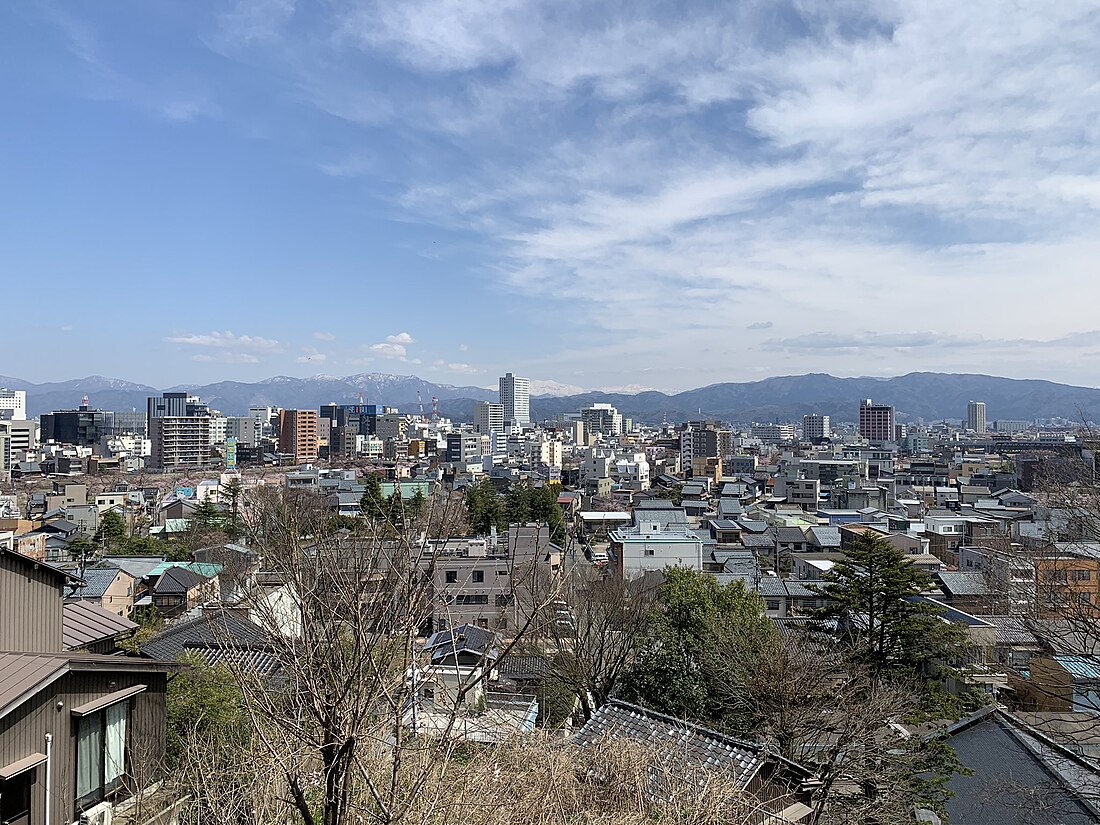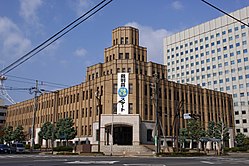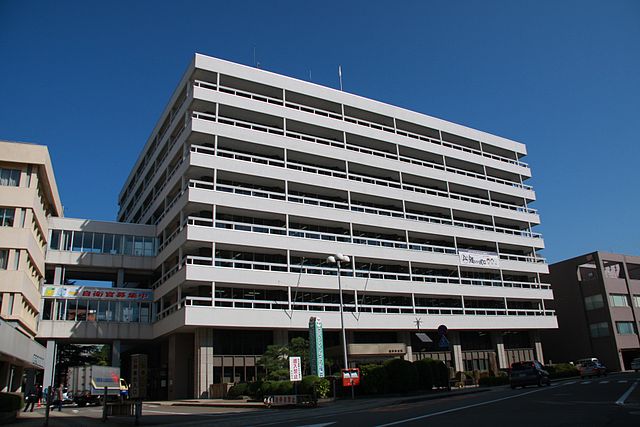Top Qs
Timeline
Chat
Perspective
Fukui (city)
Core city in Chūbu, Japan From Wikipedia, the free encyclopedia
Remove ads
Fukui (福井市, Fukui-shi; Japanese pronunciation: [ɸɯ̥.kɯꜜ(.)i, ɸɯ̥.kɯ(.)i, ɸɯ̥.kɯ.iꜜ.ɕi, ɸɯ̥.kɯꜜi.ɕi][1]) is the capital city of Fukui Prefecture, Japan. As of 1 March 2024[update], the city had an estimated population of 255,332 in 107,553 households.[2] Its total area is 536.41 square kilometres (207.11 sq mi)[3] and its population density is about 476 persons per km2. Most of the population lives in a small central area; the city limits include rural plains, mountainous areas, and suburban sprawl along the Route 8 bypass. After suffering devastation during World War 2 and an earthquake in 1948, Fukui was nicknamed 'Phoenix City', symbolising its rebirth from ashes and destruction.[4]
Remove ads
Overview
Cityscape
- Fukui Station (2018)
- Downtown of Fukui City (2018)
- Fukui City Aerial (2014)
- Skyline of Fukui City (2013)
Geography
Summarize
Perspective
Fukui is located on the coastal plain in the north-central part of the prefecture. It is bordered by the Sea of Japan to the west and the Ryōhaku Mountains to the east. The Kuzuryū River flows through the city.
Climate
Fukui has a humid subtropical climate (Köppen climate classification Cfa) with hot, humid summers and cool winters. Precipitation is high throughout the year, and is especially heavy in December and January.
Neighbouring municipalities
Remove ads
Demographics
Per Japanese census data, the population of Fukui has remained relatively steady over the past 40 years.
History
Summarize
Perspective
This section needs expansion. You can help by adding to it. (July 2018) |
Origins
Fukui originally consisted of the old provinces of Wakasa and Echizen, before the prefecture was formed in 1871.[8]
During the Edo period, the daimyō of the region was surnamed Matsudaira, and was a descendant of Tokugawa Ieyasu.[9]
Sengoku period
In 1471, Asakura had displaced the Shiba clan as the shugo military commander of Echizen Province.[10] The same year, Asakura Toshikage (1428–1481) fortified the Ichijōdani by constructing hilltop fortifications on the surrounding mountains and constructing walls and gates to seal off the northern and southern end of the valley. Within this area, he contracted a fortified mansion, surrounded by the homes of his relatives and retainers, and eventually by the residences of merchants and artisans, and Buddhist temples. He offered refuge to people of culture or skills from Kyoto attempting to escape the conflict of the Ōnin War, and the Ichijōdani became a major cultural, military, and population center, and by the time of Asakura Takakage (1493–1548) it had a peak population of over 10,000 inhabitants. Yoshikage succeeded his father as head of the Asakura clan and castle lord of Ichijōdani Castle in 1548.[11][12]
The Asakura maintained good relations with the Ashikaga shogunate, and thus eventually came into conflict with Oda Nobunaga. Following Nobunaga's capture of Kyoto, Shōgun Ashikaga Yoshiaki appointed Asakura Yoshikage as regent and requested aid in driving Nobunaga out of the capital.[13] As a result, Nobunaga launched an invasion of Echizen Province. Due to Yoshikage's lack of military skill, Nobunaga's forces were successful at the Siege of Kanegasaki and subsequent Battle of Anegawa in 1570, leaving the entire Asakura Domain open to invasion.[10][14][15]
Ichijōdani was razed to the ground by Nobunaga during the 1573 Siege of Ichijōdani Castle.[16]
Kitanosho Castle is known, though that it was built by Shibata Katsuie in 1575. Also, it appears that the tenshu (keep) was nine stories high, making it the largest of the time.
- Kitanosho Castle(Sibata Jinja)
Edo period
Castle town and centre of Fukui Domain during the Edo period Tokugawa shogunate. Fukui Domain played a key role in the Meiji restoration. The modern city of Fukui was founded with the creation of the modern municipalities system on April 1, 1889.
Meiji, Taisho, and Showa periods
During the pre-war period, Fukui grew to become an important industrial and railroad centre. Factories in the area produced aircraft parts, electrical equipment, machine motors, various metal products, and textiles.
Fukui was largely destroyed on June 19, 1945 during the Bombing of Fukui during World War II. Of the city's 1.9 sq mi (4.9 km2) at the time, 84.8% of Fukui was destroyed, per the United States Army Air Forces's Strategic Bombing Survey.
- Fukui District Court
- Fukui City Water Service Memorial
- Fukui Prefectural Office Building (1923)
Modern Fukui
Fukui was again devastated by a major earthquake in 1948.
On February 1, 2006, the town of Miyama (from Asuwa District), the town of Shimizu, and the village of Koshino (both from Nyū District) were merged into Fukui.
Fukui's city status was designated a core city on April 1, 2019.[17]
Remove ads
Government
Fukui has a mayor-council form of government with a directly elected mayor and a unicameral city legislature of 32 members. The city also contributes 12 members to the Fukui Prefectural Assembly. In terms of national politics, Fukui forms part of Fukui 1st district, a single-member constituency of the House of Representatives in the national Diet of Japan.
International relations

Sister cities
International
- Sister cities
- Friendship cities
National
- Sister cities
- Friendship cities
- Partnership cities
Remove ads
Economy


The economy of Fukui is mixed. The city is a regional commercial and finance centre; however, manufacturing, agriculture and commercial fishing also are contributors to the local economy.
Primary sector of the economy
Agriculture
- Fukui Prefecture Agricultural Cooperatives (JA FukuiPrefecture)
Fishing industry
- FukuiCity Fisheries cooperative (JF FukuiCity)
Secondary sector of industry
Manufacturing industry
Fukui is home to several companies, including:
- Kumagai Gumi, a large general construction company, was founded and has its registered head office in the city.[19]
- Matsuura Machinery, an international heavy machinery manufacturing company[20]
- Morinaga Hokuriku Dairy, a dairy products subsidiary of Morinaga Milk Industry
Tertiary sector of industry
Service industry
- Emori Shoji, a trading house with strong ties to China
- Keifuku Bus
Remove ads
Education

Universities and colleges
Secondary schools
- Asuwa Senior High School
- Fujishima Senior High School
- Fukui Commercial Senior High School
- Fukui Minami Senior High School
- Fukui Norin Senior High School
- Fukui University of Technology - Fukui Senior High School
- Hokuriku Senior High School
- Jin-ai Girl's Senior High School
- Kagaku-Gijutsu Senior High School
- Keishin Senior High School
- Koshi Senior High School
- Michimori Senior High School
- Usui Senior High School
Other schools
- Fukui Prefectural School for the Blind
- Fukui Prefectural School for the Deaf
- A North Korean school: Hokuriku Korean Elementary and Junior High School (北陸朝鮮初中級学校).[21]
Remove ads
Transport
Summarize
Perspective



(Hokuriku Expressway)

Railways
High-speed rail
Shinkansen service began on 16 March 2024, when the route was extended from Kanazawa in Ishikawa, north of Fukui Prefecture, to Tsuruga in the south of Fukui.[22]
Conventional lines
- Etsumi-Hoku Line (Kuzuryū Line): Echizen-Hanandō - Rokujō - Asuwa - Echizen-Tōgō - Ichijōdani - Echizen-Takada - Ichinami - Kowashōzu - Miyama - Echizen-Yakushi - Echizen-Ōmiya - Hakariishi
- Fukubu Line: Sanjūhassha - Taichō no Sato - Asōzu - Harmony Hall - Seimei - Ebata - Bell-mae - Hanandō - Sekijūjimae - Shokokaigisho-mae - Asuwayama-Koenguchi - Fukui Castle Ruins-daimyomachi - Jin'ai Joshikōkō - Tawaramachi
- Mikuni Awara: Fukui - Shin-Fukui - Fukuiguchi - Matsumoto Machiya - Nishi-Betsuin - Tawaramachi - Fukudaimae-Nishi-Fukui - Nikkakagaku-Mae - Yatsushima - Nittazuka - Nakatsuno - Jin'ai Ground-Mae - Washizuka-Haribara
- Katsuyama Eiheiji Line: Fukui - Shin-Fukui - Fukuiguchi - Echizen-Kaihotsu - Echizen-Shinbo - Oiwakeguchi - Higashi-Fujishima - Echizen-Shimabashi
Hapi Line Fukui
Service on the third-sector line formerly belonging to JR West began operations on 16 March 2024 when the Hokuriku Shinkansen was extended to Tsuruga.[23]
- Ōdoro - Echizen-Hanandō - Fukui - Morita
Roads
Expressways
Japan National Route
Air
The city does not have its own commercial airport. The nearest airport is served by Komatsu Airport which is located 55 km north of Fukui.[24]
Seaways
Sea Port
- Port of Takasu
Visitor attractions

- Asuwa River
- Fukui International Activities Plaza
- Harmony Hall Fukui
- Ichijōdani Asakura Family Historic Ruins, one of the most important cultural heritage sites in Japan
- Fukui Castle
- Fukui Fine Arts Museum
- Kitanosho Castle
- Peace Pagoda, the second of its kind in the world, inaugurated in 1959
- Yōkōkan Garden
- "Yoroppaken", creator of Fukui's trademark dish, sauce katsudon (ソースカツ丼)
- Yōkōkan Garden
- The Yōkōkan Kantei
- Fukui Castle
- Fukui District Court
- Fukui International Activities Plaza
- Koshino beach
Remove ads
Culture
Sports
Baseball
Handball
- Hokuriku Electric Power Company Blue Thunder (JHL)
Soccer
- Fukui Phoenix Stadium
- Fukui Prefectural Gymnasium
- Fukui Prefectural sports Park (9.98 Stadium)
- Fukui Velodrome
References
External links
Wikiwand - on
Seamless Wikipedia browsing. On steroids.
Remove ads





































